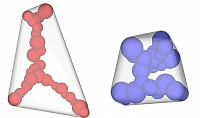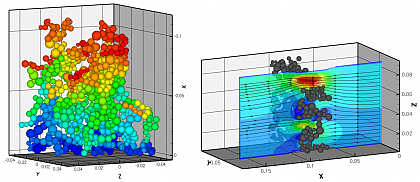Thermo chemical resistent particle filters for diesel application
Finacial support:
Bundesministerium für Bildung und Forschung (BMBF)
Grant number:
03X3502D
Title:
Thermochemical resistent cordierite for diesel particle filters CorTRePa
Head:
Prof. Dr.-Ing. M. Sommerfeld
Staff:
Dipl.-Ing. Mathias Dietzel
Partners:
Robert Bosch GmbH, Stuttgart (Koordinator)
Hermsdorfer Institut für Technische Keramik e.V., Hermsdorf
Institut für Keramik im Maschinenbau, TU Karlsruhe
Institut für Mechanische Verfahrenstechnik, Universität Halle-Wittenberg
Fraunhofer Institut für Techno- und Wirtschaftsmathematik, Kaiserslautern
Keywords:
Filter, particle deposition, soot, agglomerate, Lattice Boltzmann, drag, lift, transport
Description:
Aim of this research project is the development of a thermochemically resistant cordierite based sinter material for application in diesel soot filters of passenger cars. These substrates are to comply with future exhaust emission standards and shall replace more expensive alternative materials such as silicon carbide or sinter metals. The difficulty in applying cordierite in exhaust filters arises from its low melting point and the risk of damaging reactions in presence of oil ashes at high temperatures. This may lead to a considerable impact on the filter efficiency or even to the destruction of the filter substrate.
Regarding to the field of modeling and simulation, the influence of material design on the filtration efficiency is to be evaluated by numerical simulation of the particle laden flow as well as the deposition of soot particles inside the sinter material. The focus of the institute of mechanical process engineering is on providing data of the transport and deposition behavior of single soot agglomerates. Three-dimensional, highly resolved simulations of the flow around agglomerates and of the formation of soot layers are performed using the lattice Boltzmann method. One result of the simulations is the drag, lift and torque coefficient of the soot particles as function of the particle morphology and the flow conditions. For that purpose parameter studies are performed whereby agglomerates of different structure types are generated, morphologically characterized and subjected to laminar flow. The established correlations are used for Lagrangian modeling of agglomerate transport in less resolved simulations of filter segments. In that case agglomerates have to be represented by spherical particles due to limited computational resources, but a structure-dependent flow behavior of the particles is realized by modifying the drag coefficient according to the correlations.
In addition to the determination of aerodynamic coefficients, the porosity and permeability of growing thin soot layers is to be analyzed by highly resolved simulations. The results again provide a basis for modeling of Lagrangian simulations at the scale of the substrate by specifying a resulting cell load or cell permeability due to particle deposition. An indirect validation of both the modeling approaches and the simulation results is intended with the help of experimental data.

Types of agglomerates

Flow around an agglomerate
CorTRePa final report
CorTRePa_Abschluss.pdf
(837.7 KB) vom 18.01.2011





